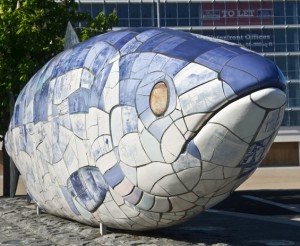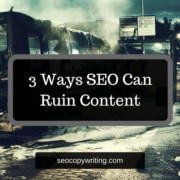The Semantic Web & Knowledge Graph with Bill Slawski
 As the go-to expert for all things Google patents for some ten years now, Bill Slawski of SEO by the Sea and Go Fish Digital has made an art and science of predicting and explaining the deep water currents driving search engine results.
As the go-to expert for all things Google patents for some ten years now, Bill Slawski of SEO by the Sea and Go Fish Digital has made an art and science of predicting and explaining the deep water currents driving search engine results.
Lately, Bill has focused on the changes to search results brought on by Google’s “Knowledge Graph” and the Semantic Web.
You’ve likely come across these terms in your work as an SEO copywriter, but what do they mean, exactly? And why should you care?
In this interview, Bill offers a straightforward explanation of these latest forces impacting search results, and why you should have a handle on them.
What should an SEO copywriter understand about the Semantic Web (vs. Traditional SEO/Search)?
Google appears to have gone into a different mode when answering search queries, which illustrates one of the big differences between the worlds of SEO and the Semantic Web.
Google’s search engine results pages (SERPs) have traditionally been a list of links to resources found on the Web that respond to a specific query typed into its search box. Google finds these resources by crawling Web pages, indexing their contents, and then returning links to the user.
In doing so, Google creates snippets representing those pages, and provides these snippets as well as their corresponding URLs and page titles, in its SERPs.
A Semantic Web approach has Google crawling web pages on a search for entities (specific people, places and things), collecting information about those entities, and adding that data to a fact repository — now known as Google’s “Knowledge Graph.”
So how does the Knowledge Graph work in the Search Landscape?
The Knowledge Graph, or “knowledge panels,” is part of the search results interface that Google uses to share information about entities – again, these entities may be specific people, places and/or things.
As for “things” — it’s important to note that they may include ideas, brands, and products.
For example, when someone performs a search that includes an entity (as many searches do), a knowledge panel about that entity appears at the top of the search engine results page. This panel provides more information about that specific entity, and often includes other related topics that people usually search for when entering their initial query.
So, search results are no longer just lists of snippets pointing to pages that are ordered by information retrieval scores and PageRank. With its knowledge panels and the Semantic Web, Google has added a number of other ways to decide what it might show on its SERPs.
Given the significant changes in search results brought on by the Semantic Web and Google’s Knowledge Graph, what would you advise an SEO copywriter do? Should s/he cite entities for better SERP rankings?
If entities appear in your content — as they often do — see if you can make the mentions of them richer by fleshing them out. Remember that a named entity includes ideas, brands, and products.
Including more information about the entities within your content can help make it more interesting, more likely to be noted by others, and shared socially.
This can mean including information about related entities, as I previously referred to. Adding this relevant, related content could make your own rank well for a wider range of search queries.
What resources would you recommend for a deeper dive into the brave new world of the Semantic Web and Knowledge Graph?
I’ve been fortunate to have teamed up with Barbara Starr, who is a founder and co-organizer of the San Diego Semantic Web Meetup Group (she added me as a co-organizer.) Barbara has strong roots in the Semantic Web Technology community, and also likes to research Google’s patents.
On June 23rd, Barbara and I collaborated on a presentation for the San Diego Semantic Web group, titled Ranking in Google Since The Advent of The Knowledge Graph.
I also highly recommend this recent (May 2015) Search Engine Land article from Barbara on changes to how Google handles search results via the Knowledge Graph: Structured Data and the SERPS: What Google’s Patents Tell us about Ranking in Universal Search.
In this post, Barbara describes how a Google patent titled Ranking search results based on entity metrics (https://www.google.com/patents/WO2014089776A1) might feature different knowledge panel content based upon metrics involving notability, relatedness (as in related to other entities mentioned), contribution, fame and prize.
So if you are creating content for pages and mentioning entities within that content, understanding more about these metrics can give you a sense of what might appear for entity-based content in search results, and perhaps give you some ideas of what to write about.
Going forward, what do you see happening with the Semantic web? Will it eclipse “traditional SEO”?
Many commercial businesses have been relying upon SEO on the Web to bring them traffic to their pages, and through their doors. But searchers often want answers as quickly as they can get them, and Semantic Web approaches are geared towards sharing data as quickly as possible.
The search engines see searchers as their primary customers, but also rely upon business owners to advertise on their pages. This may mean that traditional SEO may have some life left in it.
Connect with Bill on Twitter, Google+ and LinkedIn
Photo thanks: ©William Murphy | Flickr.com







Great interview – thanks Laura. I find the whole semantic web thing very hard to get my head around. Your questions, and Bill’s answers, made it all a lot clearer!
Damien, hi! So glad you found the interview with Bill helpful in getting a handle on the Semantic Web. It is an intimidating concept for most. And thank you for your comment! :)
SEO is such a complex subject … glad I outsourced it to the experts a couple of years ago!
Yes, Matthew, SEO is an ever-evolving practice that most business owners simply haven’t the time to master. Outsourcing to reputable SEO professionals is definitely a good call! :)